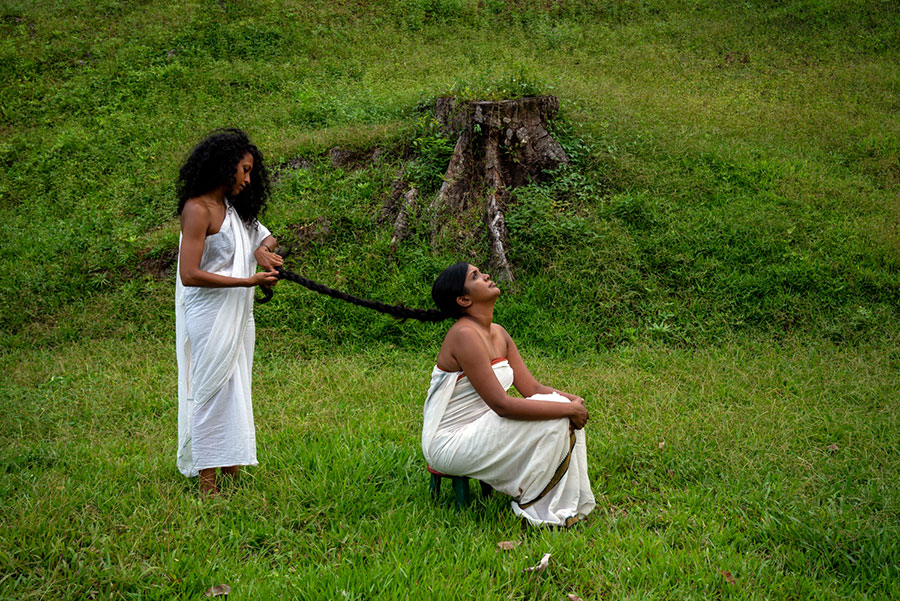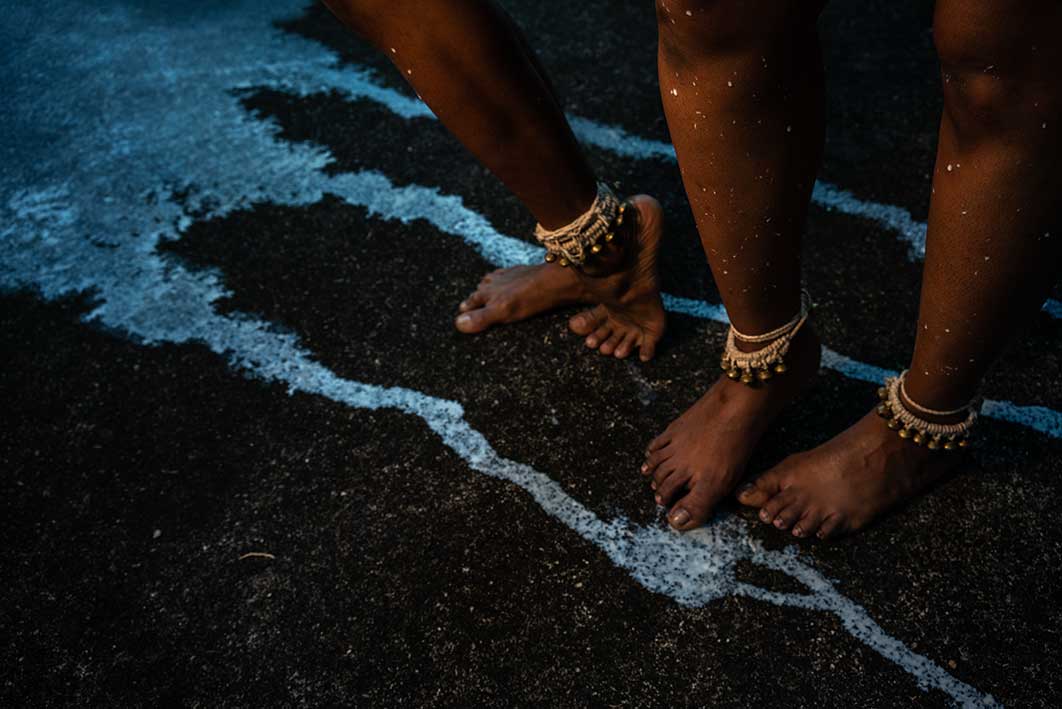Amrita Chandradas, Aarthi Sankar and Ruby Jayaseelan on Inheritance
Objectifs’ sixth Women in Film & Photography showcase opened on 11 Nov 2021 with the theme Inheritance. The final instalment of four weekly online artist talks featured documentary photographer Amrita Chandradas, and dancers Aarthi Sankar and Ruby Jayaseelan.
They discussed their collaboration on Phase/less, a short film that, informed by their own identities and experiences, unearths generational traumas, passed on superstitions, ritualistic practices and the idea of womanhood within the Tamil Singaporean community. Phase/less was commissioned by Objectifs and is Amrita’s first venture into non-documentary filmmaking.

From L-R: Aarthi Sankar, Amrita Chandradas and Ruby Jayaseelan on the opening night of Women in Film & Photography 2021.
This recap of the session has been paraphrased for brevity.
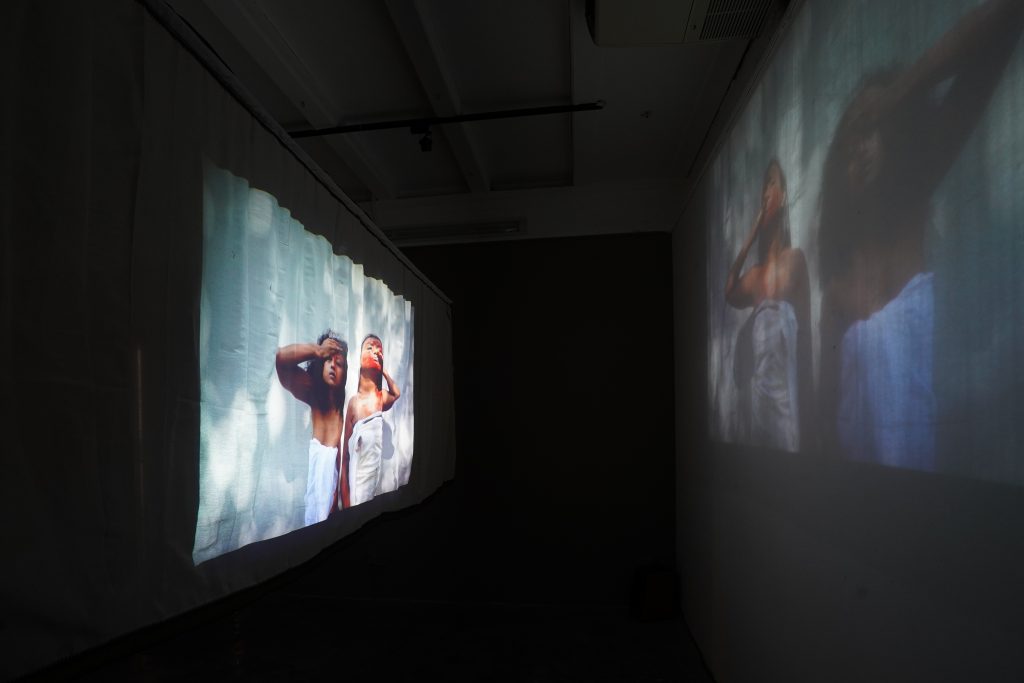
Installation view of “Phase/less”, Objectifs Lower Gallery
Inheritance & Time
The experimental 10-minute short film, Phase/less, plays on loop in Objectifs’ Lower Gallery, with “neither a beginning, middle nor end.” Its title is also a play on “faceless” — “without any visible form or face, pretty much how we felt making this film during the ever-changing phases of a pandemic”.
Due to Covid-19, the annual Women in Film & Photography programme took the form of a residency instead of an exhibition last year, unexpectedly granting Amrita more time to explore and incubate the project with Aarthi and Ruby. They began by “breaking down what inheritance means to us – traits that have been passed on through generations, whether we like it or not, that make us who we are today”. Their other key concept was “time and its cyclic nature”, with the film covering “themes of death, rebirth, stillness and femininity” and “emotions such as shame, guilt, pain, loneliness, tranquility and euphoria”.
Phase/less is rich in symbolism, “some hidden and some not”. Amrita shared: “Those not from the community have asked how they can understand Tamil Singaporeans’ traditions and customs if they are not properly explained, but we feel that many of the painful and traumatic experiences explored are universal in many aspects. Each scene has many possible connotations and we wanted to see what the audience grasped from it.”
Some noteworthy symbols and gestures in Phase/less are as follows:
The colour white
The colour white dominates the film, particularly in the dancers’ costumes. Aarthi shared: “We’ve always been enamoured with how gendered objects can be. As seen in our process documentation, we started out wearing more conventionally feminine sarees — we tried out bright colours, dark ones, white, black…”
“White holds no visible form, just like how we are unable to put a face to some of our ancestors.” Traditionally, Hindu widows also wore white, representing their giving up material pleasures and their state of mourning — also considered by many a stripping away of their own identity. “The idea of having a male or masculine energy in [their] work seemed a kind of quiet resistance”. Aarthi and Ruby wear veshtis, traditionally only worn by men, thereby “pushing the boundaries of the roles each gender is expected to conform to”.
In Objectifs’ Lower Gallery, the film is projected onto and through a veshti belonging to Aarthi’s late father. For Amrita, the secondary projection onto the wall behind the veshti alludes to the multifaceted nature of the film itself.
Female bodies and revealing / obscuring skin
Drawing from somatics, the artists explored, as Ruby put it, “the stories that subconsciously come up from our bodies; sometimes, memories emerge just from a particular body part.” They were unsure how to discuss perceptions of the female body. In Phase/less, they considered all options “from nudity to being completely draped”.
They did not wear the veshti like a saree is conventionally tied, but realised that Ruby’s paternal grandmother wore her saree in a similar style. Ruby reflected that their process was about figuring out “how the body could still be seen; how do we feel sensual while thinking about our ancestry and digging into our inheritance?”
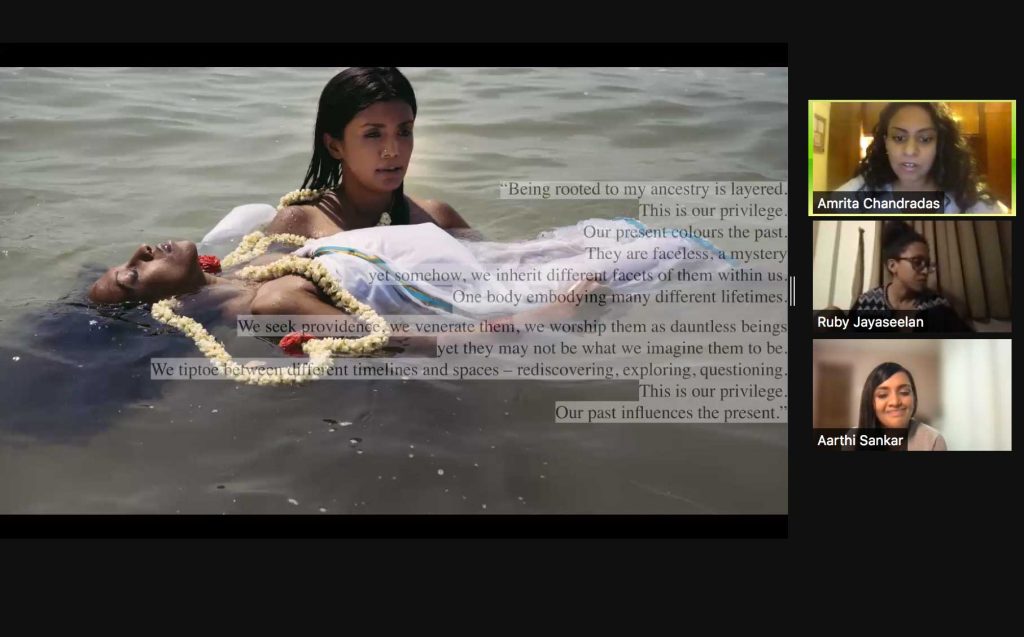
Text – Collaborative Poem
Amrita, Aarthi and Ruby collaboratively wrote the above poem, when they were trying to set the tone for the film.
First, it addresses “how ancestors are venerated on the same level as gods, not acknowledging that they were imperfect humans who made mistakes in life”. Amrita reflected: “The film’s purpose was not to resolve the many lingering doubts about our ancestry and practices that continue. Our generation has the ability to dismantle certain enforced ideas by pushing them into the open and questioning them. But sometimes an invisible shackle still ties even us down to certain beliefs”.
Further highlighting their deeply intuitive creative approach built on intimacy and trust, Aarthi highlighted how “almost nothing is choreographed in the whole film; Amrita behind the camera was dancing with [her and Ruby] as they improvised; together, [they] figured out where to go”.
Aarthi highlighted how Amrita’s images from Home Away from Home, her work-in-progress long-term personal project on growing up as a fifth generation Tamil Singaporean woman were conversation triggers that helped the trio identify and traverse their “diversity in experiences, the differences in sources of guilt and shame”, though all three come from families with fairly similar principles.
Footwork
In their exploratory footwork, the artists moved away from dancing in sarees typically worn for bharatanatyam, which include pants, and revealed their ankles, thighs and legs, which is culturally taboo. Aarthi shared: “We were enamoured by how raw it felt to reveal our jiggly thighs borne of Indian genetics, dancing while wearing the anklet bells [associated with traditional dance]”.
Milk
The artists experimented with performing their footwork on different surfaces and atop different elements – not only water, but also on milk, which is used in rituals where it is poured over religious idols as a form of offering and cleansing, and which some question as a wasteful practice that ignores the needs of individuals who could consume the milk. At the same time, Ruby highlighted how she finds it interesting that deities, including female goddesses, are shown off to the public while they are undressed and bathed in milk — the sight can be quite intimate and erotic. Ruby found it interesting that this part of the process was visible to devotees and then the altar would be closed and reopened for a grand reveal of the idol cleaned up and adorned in fine clothes, jewellery and fresh flowers.
Sambrani
Sambrani also triggers strong sensory references and memories for the trio. Sambrani is lit up and shown around the home on auspicious days of the week as a form of cleansing. The smoke can be strong, triggering tears in some people’s eyes. Sambrani is also used in prayers including ancestor worship pujas, where families pay respects to their departed relatives’ photos displayed at the family altar and offer food, flowers and prayers. For the artists, the sambrani smoke that momentarily obscures the portraits parallels the inability to fully know one’s ancestors.
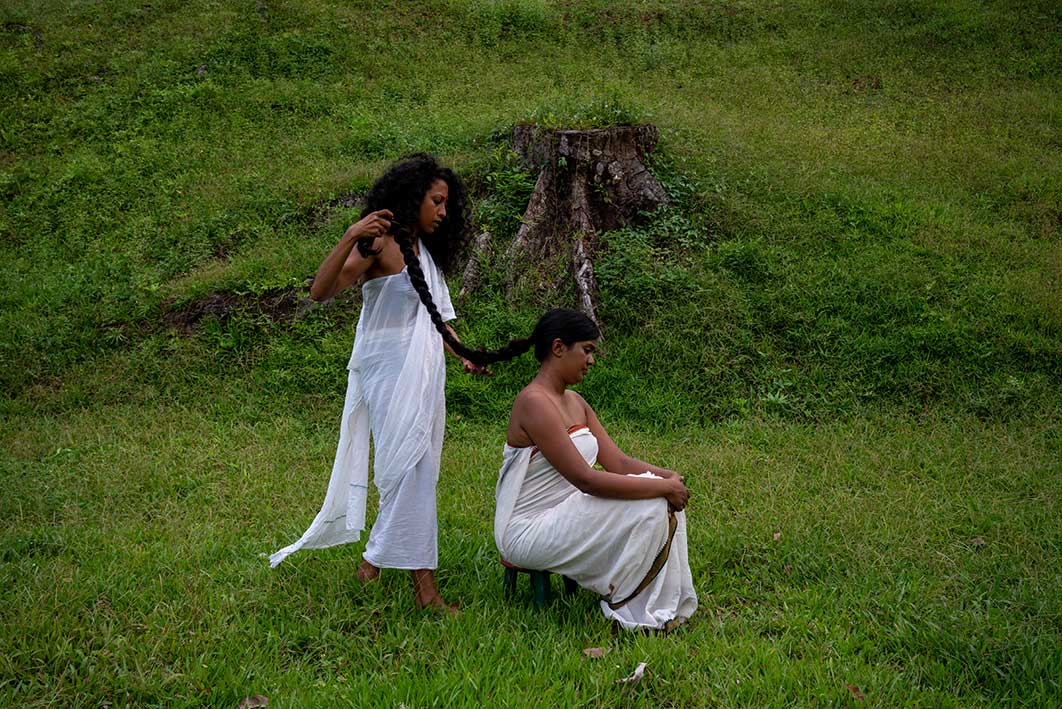
Still from “Phase/less”
Hair
Hair is a marker of femininity across cultures and it is no different for Tamil Singaporean women. Phase/less depicts the ritual of hair brushing/combing and braiding that is often performed by older women like mothers, aunts and grandmothers, for younger girls. The routine itself may be mundane but also can evoke strong memories of the methodical detangling, brushing, oiling and plaiting of hair, which can be by turns gentle or forceful.
Longer hair is considered desirable and in the film we see an idi mudi, or hair extensions, used in rituals ranging from coming-of-age festivities to weddings, as well as in bharatanatyam performances. Even as the artists recalled unpleasant memories of feeling hypervisible while still very young at their lavish puberty ceremonies, they also recalled their grandmothers persisting with haircare rituals in their older days, applying hair attachments to make up for the hair they had naturally lost, even in their final days of weak or poor health.
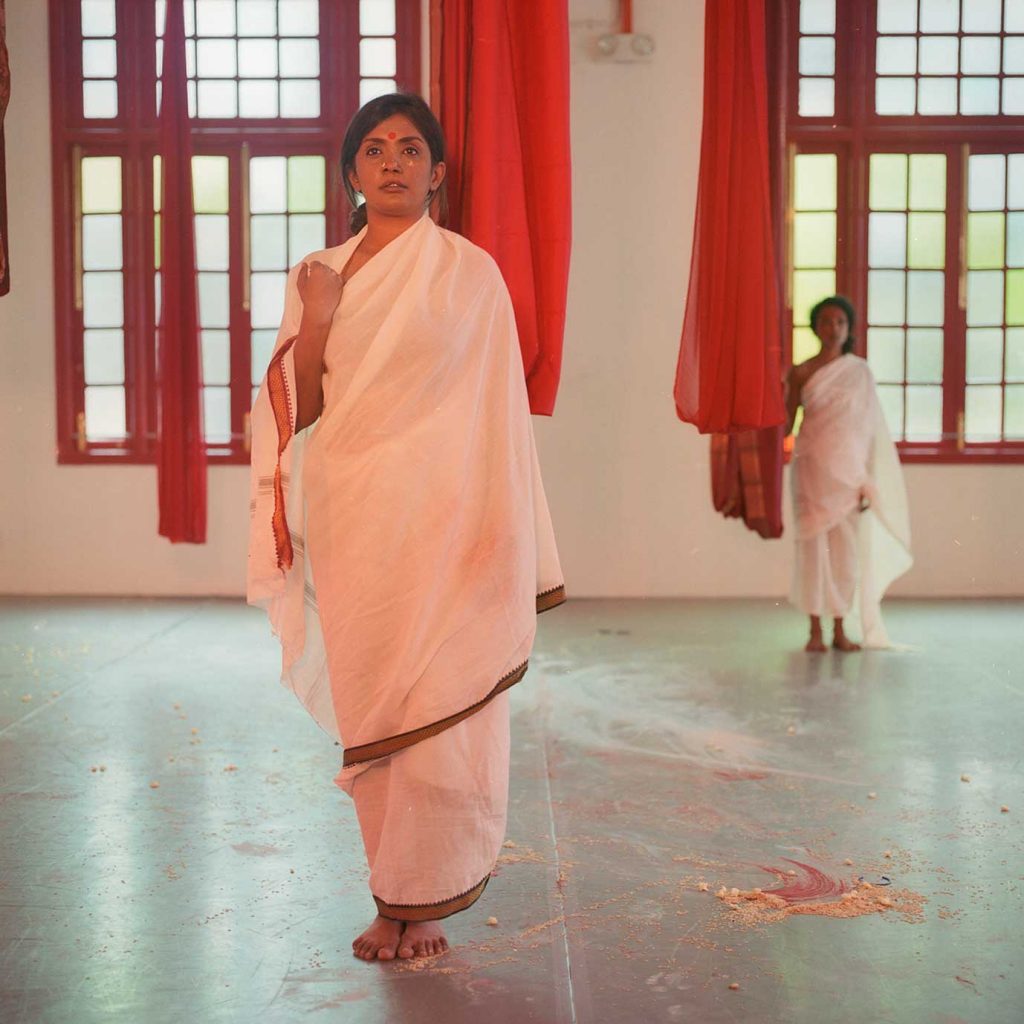
A Woman’s Worth
All of Phase/less is shot outdoors, except for one sequence that features the dancers interacting in an indoor studio with nine red cloths suspended from the ceiling, reminiscent of the cots that babies were traditionally placed in. The number nine was chosen for its significance both in the Hindu framework and for its personal meaning to the artists. Within each cot they placed different items associated with traditional — though also contemporary — indicators of what it means to be a successful brown woman.
These are not visible in the film itself but the artists revealed some during the talk: they range from indicators of fertility to even house keys as being the matriarch of a household or a property owner is considered desirable. In this segment, the dancers interact with the suspended cots and the items within them, but not with each other.
The sea: a liminal space between death and rebirth
In Phase/less, the artists examine the sea as a space that is a “juncture between death and rebirth”. Ruby, draped in a garland (which is used in auspicious, life-affirming ceremonies like engagements and weddings, but also draped over deceased ancestors’ portraits) is depicted floating in the sea, allowing the waves to move her in any direction, while Aarthi supports her.
Ruby described the scene as “a very therapeutic, spiritual experience” and the moments of physical touch with Aarthi as “very emotional” as it triggered memories of departed loved ones whose ashes, per custom, should be scattered in the water. Aarthi shared: “Many Indian funeral rituals are meant to help you detach from your grief and move forward in life. You’re supposed to throw the ashes and not look back. But it’s a bit too immediate to be too emotional, sometimes.”
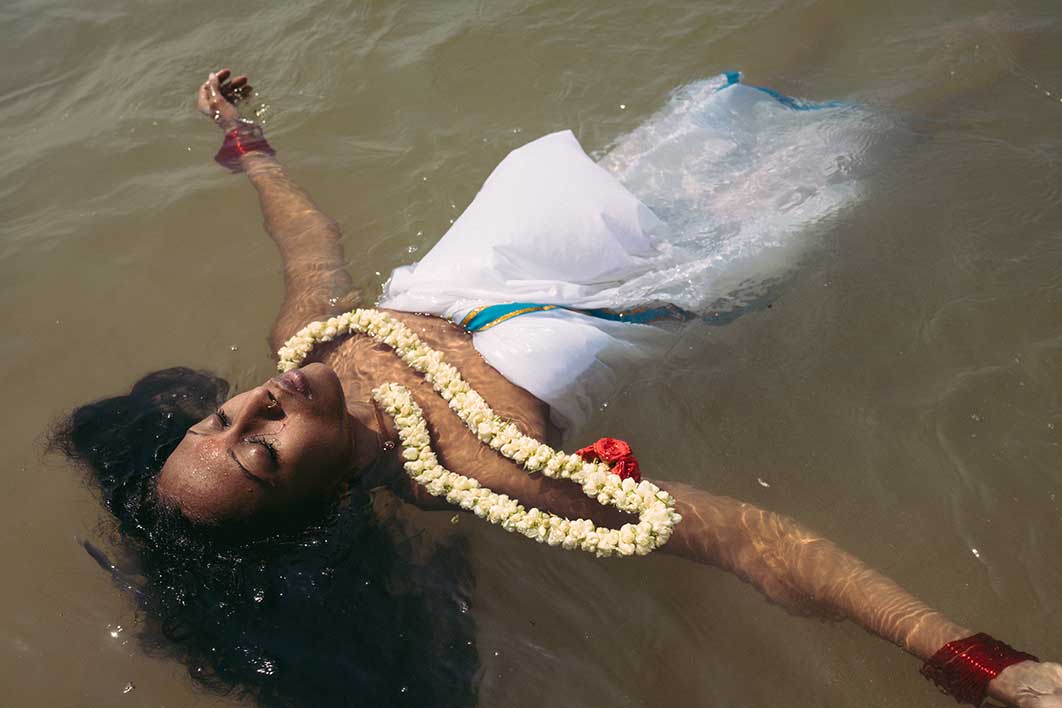
Still from “Phase/less”
Taboos around menstruation
Phase/less also addresses “the invisible boundaries created when one gets their period” such as not being permitted to enter sacred spaces like temples or the family prayer room, or even a change in expectations in the way a girl would interact with men when she starts menstruating, and the “stigma associated with menstruation”, which women are also guilty of perpetuating and inflicting on one another.
The film depicts Aarthi pouring water over Ruby, akin to a ritual performed during a puberty ceremony to celebrate a person’s menarche. The cleansing aspect of this gesture is evident in Ruby’s gestures of vigorously scrubbing herself, as though trying to get rid of the shame inflicted onto people who menstruate.
Collaborations: Editing & Sound
Amrita, Aarthi and Ruby concluded their presentation by discussing their collaborations with Adar Ng as editor and Eswandy Sarip as sound designer. Adar, whom they met during the Objectifs’ residency had insight into their process right from their shared residency experience, and offered valuable inputs on how to sequence the work.
As most of the film was shot in nature, the trio wanted to abstain from the sounds of nature and preferred more jarring soundscapes to contrast with the film’s visuals. Eswandy built the sounds rhythmically and mechanically, with some sections being bass-heavy, while others “fed off of silence”. He also incorporated sounds from recordings Amrita made in domestic spaces, such as a creaking door in her home, and the frying of mustard seeds, and wove them into the sounds he had come up with.
Q&A
In response to an audience member’s question about how their relationship with their ancestry and ancestors has shifted through making Phase/less, Amrita shared: “I’d felt fear about putting our ancestors on a high pedestal. But when we acknowledge that they were just as human as us, and have also made mistakes and gone through pain, questions emerge about how they got through it, what mindsets were like then. I feel less scared now about overstepping certain boundaries.”
For Aarthi, her mid 30s have seen her become “a bit more empathetic — more understanding and less critical — about her “shifting” relationship with her ancestors. She used to question the hero worship of people who have passed on, and why we only remember the positive about them.
For Ruby, the opportunity to work on Phase/less came at a time when she was “ready to open the doors of ancestry and inheritance in a big way through art and spirituality”. The process has offered her “many more openings in other ways with friends, relationships, expanding on ancestry and talking more to [her] own family”.
The artists were also asked who their desired audiences are for the work, to which they replied that they “hope to hear from the cis brown men in our community”. Aarthi and Ruby’s past experiences making work that push the boundaries of tradition have been met with resistance by those who “can’t get past the barriers of the body”. Aarthi said: “People only see what they want to see. I’m curious how they feel about traditions being twisted — if it offends them…what they feel about the brown woman right now.”
On the other hand, Phase/less has resonated deeply with members of the artists’ families who have viewed it. Amrita highlighted her mother’s repeated watching of the work “with so much emotion and love in her eyes” as especially moving. Aarthi stated that it was special to share the work and the viewing experience with her first sister, who has “been a huge source of energy and positivity, and who broke barriers for me to grow into who I am now. I was shielded from a lot of trauma in my household as she went through it first. She felt very differently about notions around tying hair and menstrual shame, which I didn’t experience personally.”
Aarthi, who teaches dance to children, reflected on the responsibility she feels to them. The “inheritance” she hopes to pass onto them is to equip them with “wisdom and power to deal at a much younger age with how they relate to their bodies”. She felt “very exposed when making Phase/less, as one could not hide behind the full makeup and elaborate costumes of bharatanatyam”. She also found it empowering to observe onscreen the differences between her body and Ruby’s.
Ruby reflected: “The way we responded to each other in movement was really interesting. I’ve learnt to open up a space, wait, and see what happens. Sometimes, it opens with difficult feelings.” Her takeaways were echoed by Amrita: to “embrace vulnerability and sit with uncomfortable feelings. Don’t pass on shame, and don’t glorify or demonise particular actions or feelings.” While an angry, vocal resistance to the injustices of patriarchy has long been the favoured approach, with this project, the trio “found a voice in the silence: our resistance was in no longer wanting to scream, because we are tired”.
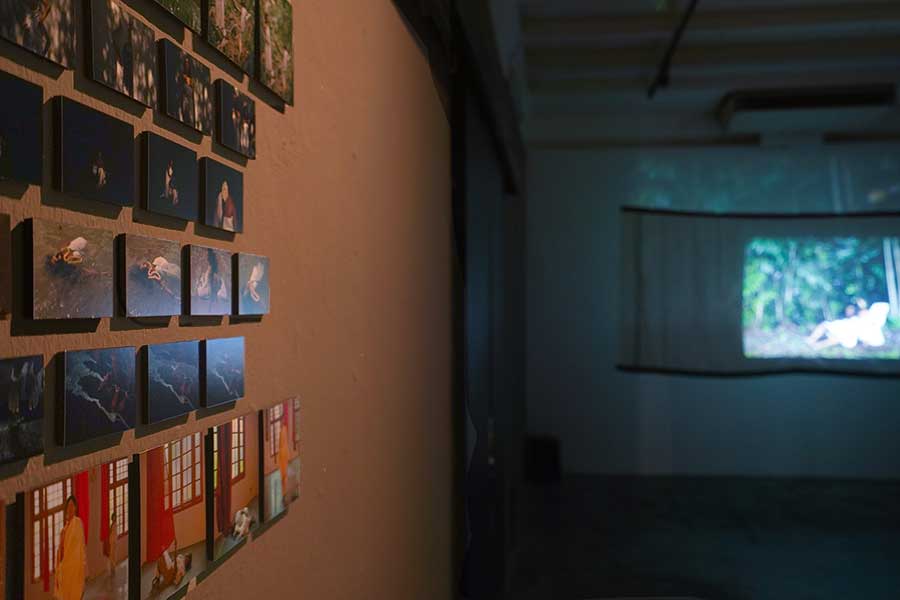
Installation view of “Phase/less”, Objectifs Lower Gallery
An audience member who identified herself as a first-generation Tamil Singaporean woman asked how brown women can empower the next generation of Tamil women and change Tamil men’s perspectives.
The artists reiterated their intention “not to change anyone’s mind but to open up spaces and see what happens”. Ruby emphasised the specificity of their vantage point: “the perspective we offer might only make sense in particular contexts. We see Phase/less very much as a piece from now. We have tried to stay rooted in a particular time and space.”
Despite this contextual specificity, Amrita expressed her belief in the possibility that “even if the work is pure ‘nothingness’ to some who watch it, it may hit them differently down the road. I’ve watched something and never fully grasped its meaning until 10 years later. The point of this was for us to acknowledge different experiences and our collective understanding.”
In Aarthi’s view, “we’re not yet at the place where brown female voices are so powerful that we can just shout and get something done. There’s still a long way to go. What we can do right now is document brown women’s lived experiences… I wish when I was 12 or 13 I’d seen brown thighs with blood flowing out of them. I would have been able to resonate with that.”
To that end, she focuses on “empowering younger women. How can we make sure they see images of themselves, their hair out there, pictures of women who look like them, who are not perfect but still get to be on television, in books? I hope that will shift perspectives.”
Summing up their experience working on Phase/less, Amrita recounted: “It was cathartic and emotional to share these experiences, which were in us for a very long time. It was a privilege to work on this. On the exhibition’s opening day, I was very overwhelmed. I never thought there would be this safe space where we could share with each other and address our differing yet relatable experiences. If you feel safe and want to share your story with someone else, go ahead and do so. It was empowering for me.”
Women in Film & Photography 2021 runs till 19 Dec. Visit our website for full details and to read recaps of the previous artist talks.

